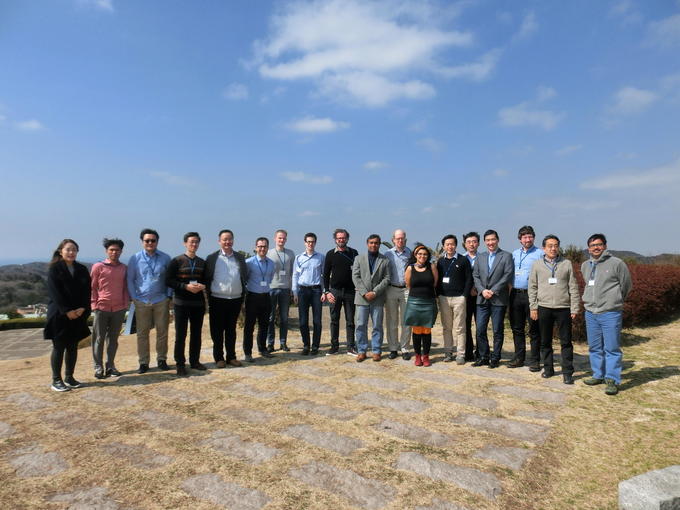NO.081 Microfluidic Biochips: Bridging Biochemistry with Computer Science and Engineering
February 27 - March 2, 2017 (Check-in: February 26, 2017 )
Organizers
- Shigeru Yamashita
- Ritsumeikan University, Japan
- Tsung‐Yi Ho
- National Tsing Hua University, Taiwan
- Robert Wille
- University of Bremen, Germany
- Krishnendu Chakrabarty
- Duke University, USA

Overview
Description of the meeting:
Advances in microfluidic technologies have led to the emergence of biochip devices for automating laboratory procedures in biochemistry and molecular biology. These devices enable the precise control of nanoliter‐scale biochemical samples and reagents. Therefore, Integrated Circuit (IC) technology can be used to transport a “chemical payload” in the form of micro‐ or nano‐fluidic carriers such as droplets or as bulk flow in microchannels. As a result, non‐traditional biomedical applications and markets (e.g., high‐throughput DNA sequencing, portable and point‐of‐care clinical diagnostics, protein crystallization for drug discovery) are opening up for ICs and systems. This represents a More than Moore‐approach.
However, continued growth (and larger revenues resulting from technology adoption by pharmaceutical and healthcare companies) depends on advances in chip integration and design‐automation tools. Thus, there is a need to deliver the same level of Computer‐Aided Design (CAD) support to the biochip designer that the semiconductor industry now takes for granted. In particular, these CAD tools will adopt computational intelligence for the optimization of biochip designs. Also, the design of efficient CAD algorithms for implementing biochemistry protocols to ensure that biochips are as versatile as the macro‐labs that they are intended to replace. This is therefore an opportune time for the software and semiconductor industry as well as circuit/system designers to make an impact in this emerging field.
Recent years have therefore seen growing interest in design methods and design‐automation tools for the digital microfluidic platform with special issues of IEEE Transactions on CAD and IEEE Design & Test of Computers, special sessions at DAC, ISPD, ASPDAC, and ICCAD, as well as workshops/tutorials at ISCAS, ICCAD, SOCC, and DATE. A number of CAD research groups worldwide (US, Germany, Taiwan, Denmark, China, Japan, India, etc.) have initiated research projects on CAD for microfluidic biochips.
The goal of the meeting is to bring together experts in order to present and to develop new ideas and concepts for the design automation algorithms and tools for microfluidic biochips. This meeting also provides a unique opportunity to bring chip designers, bioengineers, biochemists, and theoretical computer scientists together for comprehensive discussions on the research tasks as well as commercial prospects in this domain. Areas ranging from architecture, synthesis, optimization, verification, testing, and beyond should be covered.
Topics to be discussed include but are not limited to the following:
Architectural synthesis
Behavior level synthesis
Cooling for integrate circuits
Cross contamination removal
Cyberphysical integration
Device modeling
Drug delivery biochips
Fault modeling, testing, and protocol verification
Light actuated biochips
Numerical simulation
On chip sensors
Paper based microfluidics
Particle microfluidics
Physical design
Pin constrained design
Sample preparation
As possible results, we expect to see a better understanding of the respective areas, new impulses for further research directions, and ideas for areas that will heavily influence research in the domain of design automation on microfluidic biochips within the next years. The meeting will facilitate greater interdisciplinary interactions between researchers in chip designers, bioengineers, biochemists, and theoretical computer scientists.
In order to ensure high‐quality presentations and lively discussions, we carefully selected experts for invitation to the meeting. All of them have established for themselves a stellar reputation in the respective domains. While researchers working on design automation and optimization of microfluidic biochips build the majority of the invitees, also some experts from surrounding research areas should be invited. For example, researchers and industry practitioner’s people working on emerging architectures and applications of microfluidic biochips shall provide the needed insight for the discussions about the practical problem formulation for commercialized products. Computer scientists with a focus on computer‐aided design shall enrich the discussions about the top‐down design methodology and optimization of large‐scale components like mixers and routing channels. Therewith, the unique concept of Shonan meetings is applied in order to bring researchers from different domains together so that also the interdisciplinary topics can be discussed and progress in these areas is made.
